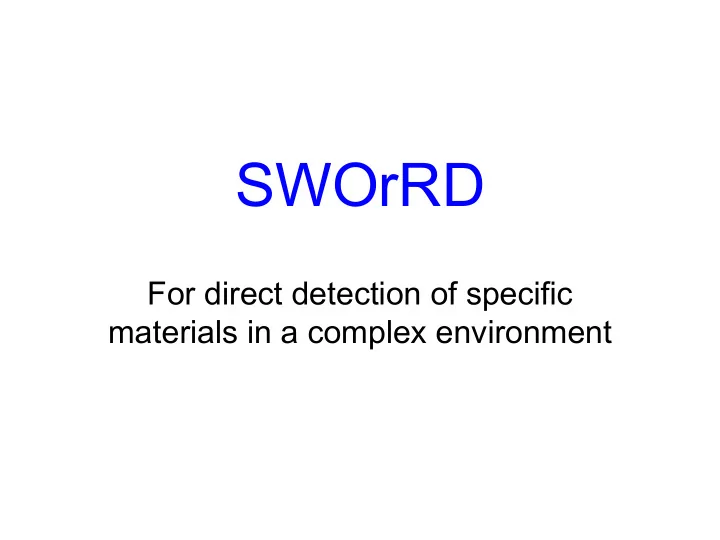

SWOrRD For direct detection of specific materials in a complex environment
SWOrRD � S wept � W avelength � O ptical � r esonant � R aman � D etector
RAMAN EFFECT Raman scattering or the Raman effect ( /�r ɑ ː m ə n/) is the inelastic scattering of a photon. It was discovered by Sir Chandrasekhara Venkata Raman and Kariamanickam Srinivasa Krishnan in liquids,[1] and by Grigory Landsberg and Leonid Mandelstam in crystals.[2][3] From Wickipedia Nobel Laureate Physics 1930
Quantum “view” of Raman Scattering
• Raman scattering is inelastic and produces photons shifted in wavelength relative to the illuminating light. Teflon Raman Spectra for 301 nm Excitation – Stokes → shifted to longer 6 wavelengths 5 – Anti-Stokes → shifted to S c a l e d i n t e n s i t y ( a u ) 4 shorter wavelengths 3 • Raman shifted photons are characteristic of the 2 scattering material and 1 can provide identification 0 600 700 800 900 1000 1100 1200 1300 1400 1500 1600 and information about -1 Stokes Shift (cm-1) molecular structures and bonds. Teflon is shown here.
W.H. Nelson, R. Manoharan, J.F. Sperry, Applied Spectroscopy Reviews 27(1) pg. 67-124 (1992). Escherichia coli
Frequency/wavelength effect on cross section or scattering probability • Scattering for all components is proportional to the incident frequency to the 4 th power – Many formulations use the shifted frequency resulting in a correction to the stokes and anti-stokes amplitudes. • The cross section for individual Raman lines depends on the induced polarizability (induced dipoles) for that state. – The cross section will be a function of frequency/wavelength . – At shorter wavelengths there may be resonance and the cross section will dramatically increase. • Raman shifts are an absorption mechanism.
• frequency agile laser operating in the Deep Ultra-Violet (210 – 320 nm) spectral region. – Narrow bandwidth laser line, suitable for Raman spectra. – Capable of tuning to arbitrary wavelengths in 0.1 nm steps. – Rapid (< 1 sec) tuning between wavelengths. • Produces 2-D Raman spectra that enhance both detection and specificity. • Operates in other spectral regions from VIS to NIR, up to 2000 nm, as required.
The SWOrRD laser uses a gain-switched Ti:sapphire oscillator, which operates at 5 kHz and generates 18-ns pulses tunable from 700 to 940 nm in 1-nmincrements. The laser beam is 2 mm in diameter and is well described by a TEM00 mode. Light from the oscillator is frequency converted to either third or fourth harmonics for an ultraviolet (UV) output from 210 to 280 nm, with a spectral width of 4 cm-1. Tuning the laser to any of 200 wavelengths is computer controlled and synchronized with the angular positions of gratings in the spectrometers. Switching wavelengths takes 1 min. Average power in the UV varies with wavelength from a minimum of 1 mW to a maximum of 15 mW
Based on kHz Optical Parametric Oscillator (OPO) laser technology Broad tuning range 1000 1kHz with high average power IR Line width < 4cm -1 UV Tunable in 0.1nm steps Average power (mW) 100 < 1 second to tune wavelength 10 VIS 1 200 200 300 400 500 600 700 800 900 1000 1000 2000 Wavelength (nm) Wide Wavelength Range & High Power
Block Diagram of Experiment Sh utter LA SER M irror Flip Mirror Power Meter CON TRO L CO MPUTER CCD Spectrograph (2) Spectrograph (1) Sam ple
SWOrRD Crew Crew SWOrRD Illumination Laser Spectrometer Computer control Sample holder
Figure 3. ORASIS identifying bacteria. Panels show the results of a search for a different bacterial species within each of 15 samples, shown on the horizontal axis. The vertical axis is the ORASIS abundance coefficient indicating the presence or absence of sought-for bacteria.
Potential Applications (incomplete list) • Chemicals – Warfare agents/Hazardous – Content/Composition • Biologicals – Warfare agents – Pathogens ( in situ ?) – Tissue • Pharmaceuticals – Identification/contamination/counterfeit • Mineral Composition – Nuclear Material (Ore) point of origin – Paints/Inks
Improvements (incomplete) • Laser – Size/weight/efficiency • Sample – Collection/preparation/handling – Illumination/light-collection efficiency • Spectrometer/Detector – Light efficiency – Simplicity/size/weight • Analysis – Optimization/discrimination/sensitivity
Recommend
More recommend